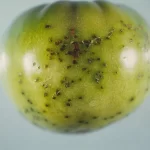Xanthomonas euvesicatoria
What is Xanthomonas euvesicatoria?
Xanthomonas euvesicatoria is a bacterium that causes bacterial spot disease in plants of tomatoes and peppers [1,2]. It is aerobic and has a long tail (flagellum), allowing it to move in water. Please refer to Figure 1 where the flagellum can be seen on the bottom right side of the image. The flagellum allows the bacteria to invade wet plant tissue through the stomata and cause infection [1]. When Xanthomonas euvesicatoria makes its way into a plant, it can cause leaf and fruit spots, which can eventually lead to yield loss. Under unfavourable conditions, the pathogen can cause up to 50% crop loss in plants and is a global problem among growers [3].
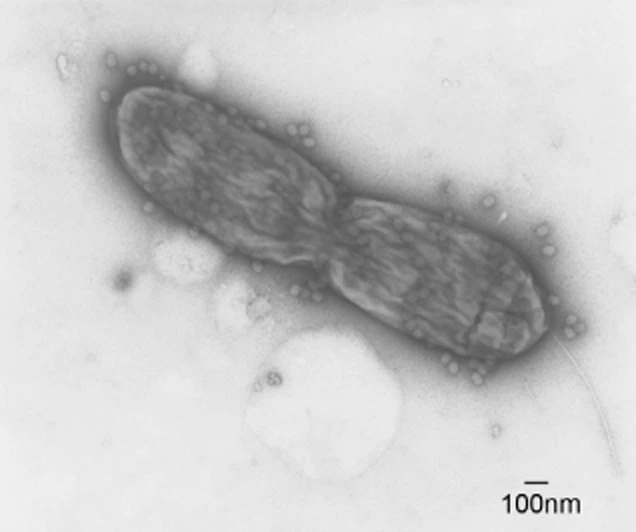
Symptoms
Xanthomonas euvesicatoria causes bacterial spot and symptoms are similar on both tomato and pepper plants. Once a plant is infected, growers will notice round, water-soaked spots on leaves [1]. These spots are usually brown or black and may be surrounded by a faint yellow circle on the outside [4]. Smaller lesions usually combine with other small lesions on fruit and leaves to create larger ones. The colour of spots also changes to a reddish-brown as lesions continue to grow. The lesions are more common at the tip and margin of the leaf, as this is where moisture is usually retained [5]. Infected pepper leaves usually fall prematurely, which leaves the fruits exposed to the sun [4]. Compared to spots on the fruit, they begin as pale green water-soaked areas and eventually become raised, brown and rough on the fruit as the disease progresses [5].
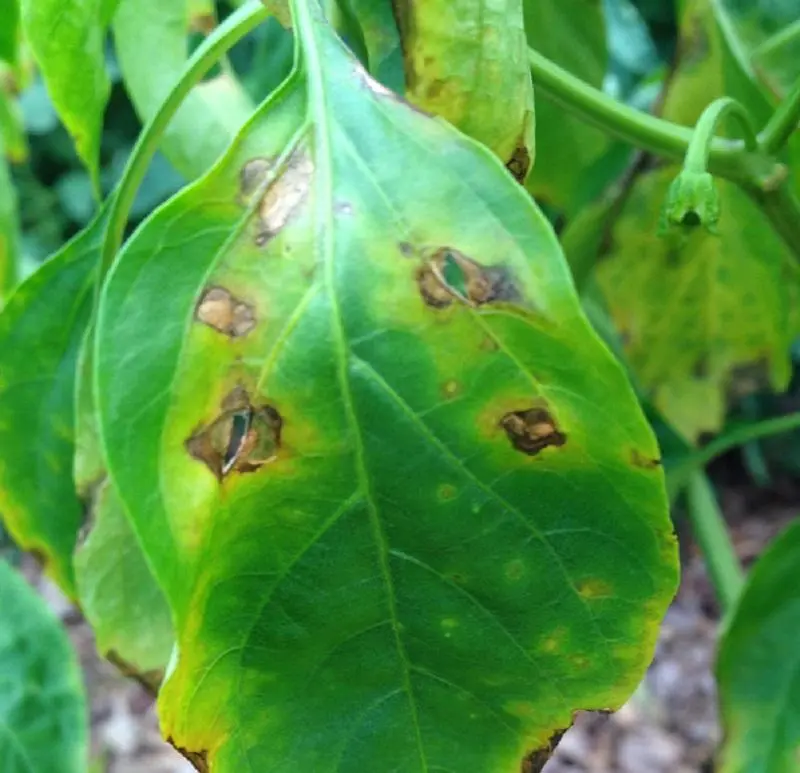
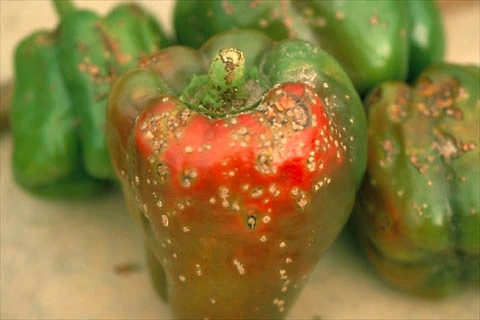
(https://www.apsnet.org/edcenter/disandpath/prokaryote/pdlessons/Pages/Bacterialspot.aspx)
We provide great overviews of many agricultural microorganisms. Subscribe to stay updated!
Life Cycle and Infection Stages:
Bacterial spot disease is spread through overhead irrigation water in greenhouses or during water splashes that happen during wet and windy conditions in outdoor crops. Although the disease is spread through water, it can also be introduced in seeds, undecomposed crop residue, or other host plants [6]. Xanthomonas euvesicatoria can survive in plant debris in soil for up to 2 years and in free soil for up to 6 weeks [7].
There are two stages in which Xanthomonas euvesicatoria infects a plant and leads to bacterial spot disease. The first is the epiphytic phase, which is when the bacteria come in contact with aerial surfaces like leaves and fruit. The bacteria then enter the plant through openings such as the stomata, wounds or hydathodes [2]. The second phase happens after the bacteria has penetrated the plant. This phase is known as the endophytic phase, when the bacteria multiply within the host tissue. At this stage, the bacterial cells can move back out onto the plant’s surface and infect other plants through rain, wind and irrigation dispersal. Once the bacterial cell reaches a new plant, the cycle starts again. Once enough of the bacterial cells are in the plant, they penetrate the mesophyll tissue, which is when symptoms are seen on leaves and fruit [2].
Mesophyll tissue – This is the internal tissue that is located between two outer cell layers of the leaf. This tissue plays an integral role in photosynthesis [9].
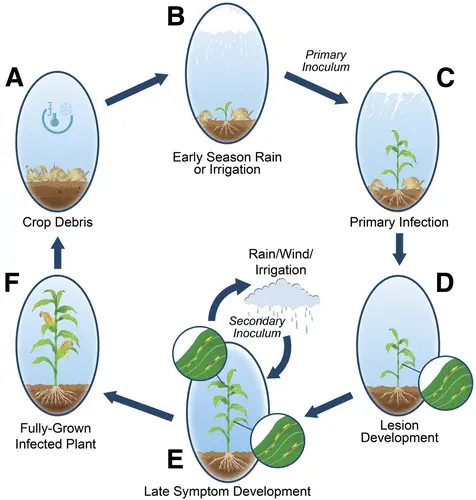
Growth conditions for Xanthomonas euvesicatoria
Xanthomonas euvesicatoria thrives in hot and humid conditions, the bacteria need a temperature on average of 25–35°C to allow for dispersal. High humidity is required for epiphytic survival, allowing the disease to be spread easily between plants in the greenhouse [7]. For field growers, tropical storms, heavy rainfall and tornadoes are periods of concern as the pathogen can spread from far away and infect crops [7].
Methods of Prevention and Control
Once a plant is infected with the bacteria, there is no way for it to recover. The only appropriate action at this stage is destruction of the infected plant [8]. Other methods of control, once infection has been detected are [8]:
- Limit access to areas where plants are suspected to carry the bacteria
- Early identification is key to control. This includes things such as scouting and routine surveillance
- Disposable gloves and aprons are recommended for scouting and removal of infected plants
- Disinfect gloves, aprons, and bench surfaces with quaternary ammonium compounds or other disinfectants, each time plants are removed
- Remove and dispose of plants/pots/soil in doubled, heavy duty garbage bags leaving no debris behind.
In order to prevent infection in a greenhouse, the following steps can be taken as a precaution [8]:
- Keep liners from all vegetative and seed sources separated when possible.
- Test seeds and plants before they are planted
- Use gloves and disinfecting dips when planting and while handling plants
- When possible, provide enough space between plants to avoid leaf to leaf contact
- Reduce humidity in the greenhouse to encourage dry foliage
- Apply irrigation at low pressure directed at the plant, to avoid splashing of water.
- Avoid excess moisture and late-day irrigation
- When completing spray applications avoid runoff and high pressure over-spray
- If possible, use drip irrigation instead of overhead irrigation
- Don’t recycle or reuse irrigation water
Conclusion
Xanthomonas euvesicatoria is an opportunistic pathogen that can be irritating to control once the disease phase starts. Once a plant has symptoms, there is no treatment for it. Therefore, preventative practices are the most effective way of keeping it at bay. learn more about how early detection can help, feel free to email us at [email protected].
Disclaimer:
The information we present in Pathogen Profile is based on collating published peer-reviewed scientific literature and sources we think are reliable. This is by no means an exhaustive review of pathogens. Pathogen Profile gives a small glimpse of what is known about pathogens. We encourage growers to do more research on the pathogens concerning their crops and hydroponic systems. We are not plant pathologists; thus, the information presented in the Pathogen Profile should not be used as professional advice to treat pathogens or operate your hydroponic system.
References
- Scherer, A., Meadows, I., & Henson, M. (2019). Bacterial Spot of Pepper and Tomato. NC State Extension Publications. Retrieved from https://content.ces.ncsu.edu/bacterial-spot-of-pepper-and-tomato
- Utami, D., Meale, S. J., & Young, A. J. (2022). A Pan-Global Study of Bacterial Leaf Spot of Chilli Caused by Xanthomonas spp. Plants, 11(17), 2291. MDPI AG. Retrieved from http://dx.doi.org/10.3390/plants11172291
- Dhakal, U., Dobhal, S., Alvarez, A. M., & Arif, M. (2019). Phylogenetic Analyses of Xanthomonads Causing Bacterial Leaf Spot of Tomato and Pepper: Xanthomonas euvesicatoria Revealed Homologous Populations Despite Distant Geographical Distribution. Microorganisms, 7(10), 462. https://doi.org/10.3390/microorganisms7100462
- Koppert Global. (n.d.). Bacterial spot. Retrieved January 4, 2023, from https://www.koppert.com/challenges/disease-control/bacterial-spot/
- Ritchie, D.F. (2000). Bacterial spot of pepper and tomato. The Plant Health Instructor. doi: 10.1094/PHI-I-2000-1027-01
- Queensland Government. (2022). Bacterial spot. Business Queensland. Retrieved from https://www.business.qld.gov.au/industries/farms-fishing-forestry/agriculture/biosecurity/plants/diseases/horticultural/bacterial-spot
- An, S. Q., Potnis, N., Dow, M., Vorhölter, F. J., He, Y. Q., Becker, A., Teper, D., Li, Y., Wang, N., Bleris, L., & Tang, J. L. (2020). Mechanistic insights into host adaptation, virulence and epidemiology of the phytopathogen Xanthomonas. FEMS microbiology Reviews, 44(1), 1–32. https://doi.org/10.1093/femsre/fuz024
- Drotleff, L. (2017, December 21). Plantpeddler Provides Guidelines for Xanthomonas Bacterial Leaf Spot in Begonias. Greenhouse Grower. Retrieved from https://www.greenhousegrower.com/production/disease-control/plantpeddler-provides-guidelines-for-xanthomonas-bacterial-leaf-spot-in-begonias/
- Nadal, M., Flexas, J. (2018). Chapter 17 – Mesophyll Conductance to CO2Diffusion: Effects of Drought and Opportunities for Improvement. Water Scarcity and Sustainable Agriculture in Semiarid Environment, Academic Press. 403-438. https://doi.org/10.1016/B978-0-12-813164-0.00017-X.
![]()
Tanya Irani is a Bioinformatician and Agriscience Advisor at Healthy Hydroponics


